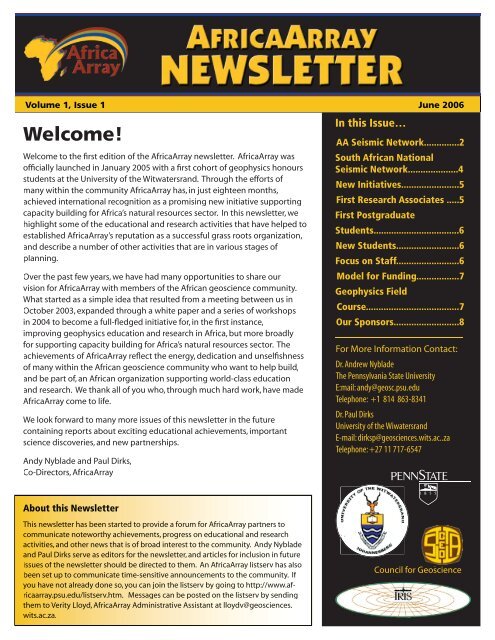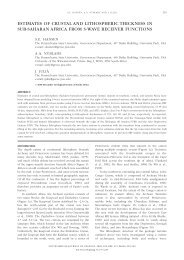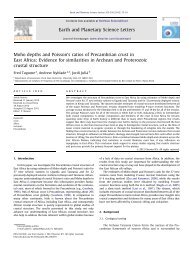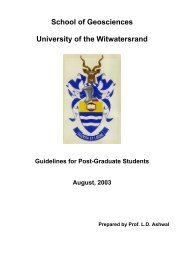View web-optomized newsletter - AfricaArray - Penn State University
View web-optomized newsletter - AfricaArray - Penn State University
View web-optomized newsletter - AfricaArray - Penn State University
Create successful ePaper yourself
Turn your PDF publications into a flip-book with our unique Google optimized e-Paper software.
Volume 1, Issue 1 June 2006<br />
Welcome!<br />
Welcome to the first edition of the <strong>AfricaArray</strong> <strong>newsletter</strong>. <strong>AfricaArray</strong> was<br />
officially launched in January 2005 with a first cohort of geophysics honours<br />
students at the <strong>University</strong> of the Witwatersrand. Through the efforts of<br />
many within the community <strong>AfricaArray</strong> has, in just eighteen months,<br />
achieved international recognition as a promising new initiative supporting<br />
capacity building for Africa’s natural resources sector. In this <strong>newsletter</strong>, we<br />
highlight some of the educational and research activities that have helped to<br />
established <strong>AfricaArray</strong>’s reputation as a successful grass roots organization,<br />
and describe a number of other activities that are in various stages of<br />
planning.<br />
Over the past few years, we have had many opportunities to share our<br />
vision for <strong>AfricaArray</strong> with members of the African geoscience community.<br />
What started as a simple idea that resulted from a meeting between us in<br />
October 2003, expanded through a white paper and a series of workshops<br />
in 2004 to become a full-fledged initiative for, in the first instance,<br />
improving geophysics education and research in Africa, but more broadly<br />
for supporting capacity building for Africa’s natural resources sector. The<br />
achievements of <strong>AfricaArray</strong> reflect the energy, dedication and unselfishness<br />
of many within the African geoscience community who want to help build,<br />
and be part of, an African organization supporting world-class education<br />
and research. We thank all of you who, through much hard work, have made<br />
<strong>AfricaArray</strong> come to life.<br />
We look forward to many more issues of this <strong>newsletter</strong> in the future<br />
containing reports about exciting educational achievements, important<br />
science discoveries, and new partnerships.<br />
Andy Nyblade and Paul Dirks,<br />
Co-Directors, <strong>AfricaArray</strong><br />
In this Issue…<br />
AA Seismic Network..............2<br />
South African National<br />
Seismic Network....................4<br />
New Initiatives.......................5<br />
First Research Associates .....5<br />
First Postgraduate<br />
Students..................................6<br />
New Students.........................6<br />
Focus on Staff.........................6<br />
Model for Funding.................7<br />
Geophysics Field<br />
Course.....................................7<br />
Our Sponsors..........................8<br />
For More Information Contact:<br />
Dr. Andrew Nyblade<br />
The <strong>Penn</strong>sylvania <strong>State</strong> <strong>University</strong><br />
E:mail: andy@geosc.psu.edu<br />
Telephone: +1 814 863-8341<br />
Dr. Paul Dirks<br />
<strong>University</strong> of the Wiwatersrand<br />
E-mail: dirksp@geosciences.wits.ac..za<br />
Telephone: +27 11 717-6547<br />
About this Newsletter<br />
This <strong>newsletter</strong> has been started to provide a forum for <strong>AfricaArray</strong> partners to<br />
communicate noteworthy achievements, progress on educational and research<br />
activities, and other news that is of broad interest to the community. Andy Nyblade<br />
and Paul Dirks serve as editors for the <strong>newsletter</strong>, and articles for inclusion in future<br />
issues of the <strong>newsletter</strong> should be directed to them. An <strong>AfricaArray</strong> listserv has also<br />
been set up to communicate time-sensitive announcements to the community. If<br />
you have not already done so, you can join the listserv by going to http://www.africaarray.psu.edu/listserv.htm.<br />
Messages can be posted on the listserv by sending<br />
them to Verity Lloyd, <strong>AfricaArray</strong> Administrative Assistant at lloydv@geosciences.<br />
wits.ac.za.
<strong>AfricaArray</strong> Seismic Network<br />
In order to build science infrastructure, support the science community, and generate data sets for student<br />
research projects, <strong>AfricaArray</strong> has over the past eighteen months established a “backbone” network of<br />
permanent broadband seismic stations for recording earthquakes across eastern and southern Africa. The<br />
network includes 18 stations as of July 2006. An additional 6 stations are scheduled for installation by the end of<br />
2006, and another five to ten stations will be installed in 2007.<br />
The network has grown rapidly because of strong support from partner organizations in many countries<br />
that have provided access to existing infrastructure. In some cases, data from operational stations have been<br />
provided to <strong>AfricaArray</strong>. In other cases, access to existing vaults and some functional equipment has been<br />
provided. And in a few cases new stations have been built from scratch. It is anticipated that over the next few<br />
years the network will expand into many more countries, especially in central and western Africa. Substantial<br />
support for building the network has come from the Incorporated Research Institutions for Seismology (IRIS).<br />
IRIS has provided <strong>AfricaArray</strong> with many refurbished RefTek data loggers for use in the network.<br />
The map below shows the current and projected distribution of <strong>AfricaArray</strong> broadband stations that will be<br />
operational by December 2007. The eleven stations in South Africa belong to the South Africa National Seismic<br />
Network, and the next article in this <strong>newsletter</strong> describes significant upgrades to these stations that are nearing<br />
completion. The feature box on the next page shows a collage of photos and data from the <strong>AfricaArray</strong> station<br />
in Itezhi-tezhi (TEZI), Zambia that was installed in January 2006.<br />
40<br />
20<br />
5200<br />
3000<br />
2000<br />
1500<br />
1000<br />
500<br />
0<br />
-7600<br />
elevation (m)<br />
0<br />
-20<br />
<br />
<br />
<br />
<br />
<br />
<br />
<br />
<br />
<br />
<br />
<br />
<br />
<br />
-40<br />
340 0 20 40 60<br />
2 <strong>AfricaArray</strong> Newsletter
An example of an <strong>AfricaArray</strong> seismic station at Itezhi-Tezhi, Zambia , and data from the<br />
magnitude 7.0 Mozambique earthquake, 22 February 2006<br />
Photo showing the seismic vault at station TEZI.<br />
Fault scarp from the magnitude 7.0 Mozambique<br />
earthquake of 22 February, 2006 showing 1-2 meters<br />
of offset. (Courtesy of M. Mustafa, INAM, Maputo,<br />
Mozambique.)<br />
Photo from inside the TEZI station showing<br />
the concrete pier, data logger and broadband<br />
seismometer (covered with foam insulation)<br />
Map showing the location of station TEZI in Zambia and the epicenter<br />
of the magnitude 7.0 earthquake on 22 February 2006 in southern<br />
Mozambique. The epicenter location is shown with a “beachball” focal<br />
mechanism indicating that a normal fault ruptured during this earthquake.<br />
<strong>AfricaArray</strong> Newsletter 3
South Africa National Seismic Network (SANSN)<br />
The South Africa National Seismic Network (SANSN) is operated by the Council for Geoscience (CGS) and<br />
includes many broadband and short period stations. The CGS is providing data to <strong>AfricaArray</strong> from eleven<br />
broadband stations, which constitutes are very substantial commitment to <strong>AfricaArray</strong> on the part of the<br />
CGS. The locations of the stations are shown on the map below (yellow and blue circles). In addition to<br />
broadband sensors, these stations are equipped with EARS data loggers (built by the CGS) and a 24 bit<br />
digitizers.<br />
During the later half of 2005, the CGS undertook a study at their Silverton (Pretoria) station to evaluate the<br />
possibility for using the SEISCOMP recording system (developed by GFZ- Potsdam) for recording in SEED<br />
format, and for using cellular communication systems for retrieving data in quasi real-time. The results of<br />
the study were promising, and in 2006 the CGS initiated a programme to install the SEISCOMP software<br />
and GPRS Cellular communication at all the SANSN stations. So far, the <strong>AfricaArray</strong> stations shown with<br />
yellow symbols on the map have been successfully upgraded.<br />
<br />
<br />
<br />
<br />
LEP<br />
<br />
MOPA<br />
<br />
BFT<br />
<br />
<br />
UPI<br />
<br />
SWZ<br />
<br />
SEK<br />
<br />
POG<br />
<br />
<br />
CVNA<br />
<br />
PKA<br />
<br />
HVD<br />
LE G E N D<br />
<br />
U p g ra d e d<br />
<br />
N o t U p g r a d e d<br />
<br />
GRM<br />
<br />
100 0 100 200 o<br />
<br />
4 <strong>AfricaArray</strong> Newsletter
New Initiatives<br />
<strong>AfricaArray</strong> mine seismic network in South Africa<br />
Through funding from the U.S. Department of Energy, a network of five broadband seismic stations will be built<br />
in early 2007 around the deep gold mines in the Carletonville district. Data from the network will be combined<br />
with in-mine seismic data as well as data from other <strong>AfricaArray</strong> stations to study the source properties of<br />
mining-related events and how seismic energy propagates at regional distances (200-1000 km). Partners in this<br />
project include the Council for Scientific and Industrial Research, the Council for Geoscience, Wits, <strong>Penn</strong> <strong>State</strong>,<br />
Lawrence Livermore National Lab (US), and Anglo Gold Ashanti.<br />
<strong>AfricaArray</strong> geoscience eLearning project<br />
A five year <strong>AfricaArray</strong> programme is being planned to develop a complete open access undergraduate<br />
geoscience eLearning package focused on African geology and tectonics, which will be made available via a<br />
dual program of CD-ROM delivery and on-line access. The on-line delivery of the materials may be in association<br />
with formal on-line training partners, and will commence with a course in geophysics. The materials will be<br />
initially developed by an <strong>AfricaArray</strong> team, but will then, in association with local African partners, be extended<br />
to support regional languages and geological contexts. Mark Jessell at the Institute de Recherche pour le<br />
Développement (Toulouse, France) is leading this effort, and anyone interested in participating should contact<br />
him (mjessell@lmtg.obs-mip.fr)<br />
<strong>AfricaArray</strong> oil and gas courses<br />
With the assistance from TOTAL, the Total Professeurs Association (a group of retired oil industry professionals<br />
and former employees of TOTAL) has agreed to provide specialist geoscience courses in oil and gas exploration,<br />
to supplement the Honours training programmes in Geology and Geophysics at Wits. This initiative will<br />
commence in September 2006 with a 2-week course in 3-D seismic surveys and reservoir characterization and a<br />
2-day course in well log analysis. We hope to expand the course offerings in future years.<br />
First Research Associates<br />
In 2006, the first <strong>AfricaArray</strong> research associates began at Wits sponsored by Schlumberger’s Faculty for the Future<br />
Programme.<br />
Jane Gore is from Harare, Zimbabwe, where she is a lecturer in the Physics Department at the<br />
<strong>University</strong> of Zimbabwe. Jane began her postdoc in late 2005 by visiting Wits and early 2006 by<br />
visiting <strong>Penn</strong> <strong>State</strong>. During the first year of her programme, Jane is working on publishing two<br />
papers from her Ph.D. thesis on the crustal and uppermost mantle structure of the Zimbabwe<br />
Craton and Limpopo Belt using data from the Kaapvaal Seismic Project. In subsequent years,<br />
Jane will spend time at Wits initiating new research projects and in Zimbabwe setting up<br />
<strong>AfricaArray</strong> seismic stations, allowing her to better image the structure of the Zimbabwe Craton.<br />
Jane holds BSc (Hons) and Ph.D. degrees from the <strong>University</strong> of Zimbabwe.<br />
Lindsay Linzer is from Johannesburg, South Africa where she works for the Council for<br />
Scientific and Industrial Research (CSIR) in the area of mining seismology and mine safety.<br />
Lindsay is focusing on broadening her background in reflection seismology, global seismology<br />
and oil and gas geology by taking courses in these topics at <strong>Penn</strong> <strong>State</strong> <strong>University</strong> (2006,<br />
2007). After completing her programme, Lindsay hopes to teach courses in these areas at Wits,<br />
thereby expanding the course offerings at Wits to include seismology topics relevant to oil, gas,<br />
and mineral exploration. Lindsay will also be working on publishing a number of papers on<br />
mine seismicity. Lindsay holds BSc (Hons) and Ph.D. degrees from Wits.<br />
<strong>AfricaArray</strong> Newsletter 5
First Postgraduate Students<br />
Martin Brandt is from Pretoria, South Africa where<br />
he works for the Council for Geoscience. He started<br />
his Ph.D. program in Seismology at the <strong>University</strong> of<br />
the Witwatersrand (Wits), Johannesburg in January<br />
2006. He obtained a BSc (Hons) in Geophysics (1992)<br />
from the <strong>University</strong> of Pretoria and completed an<br />
MSc (2000) at the <strong>University</strong> of Bergen, Norway. He is<br />
pursuing his Ph.D. part time through the <strong>AfricaArray</strong><br />
sandwich program, with co-superviors Prof. Gordon Cooper at Wits and Prof.<br />
Steve Grand at the Univeristy of Texas - Austin. The primary focus of his Ph.D.<br />
research is to image the S velocity structure of the mantle beneath southern<br />
Africa by inverting seismic waves recorded at regional distances, and through<br />
tomographically inverting travel times from teleseismic S body waves.<br />
Eldridge Kagswane is from Pretoria, South Africa,<br />
where he works for the Council for Geoscience. He<br />
started in Ph.D. in August 2005 in the <strong>AfricaArray</strong><br />
sandwich program, and is co-supervised by Prof. Paul<br />
Dirks at Wits and Prof. Andy Nyblade at <strong>Penn</strong> <strong>State</strong><br />
<strong>University</strong>. Eldridge spent four months at <strong>Penn</strong> <strong>State</strong><br />
in 2005 to get started on the first part of his thesis<br />
project, which entails jointly inverting surface wave<br />
group velocity measurements and receiver functions for lithospheric structure<br />
beneath southern Africa. Eldridge obtained BSc (Hons) and MSc degrees in<br />
Geophysics from Wits (1999, 2001).<br />
New Students<br />
A number of other <strong>AfricaArray</strong> students have begun or will soon begin in the<br />
post-graduate degree programs at Wits and <strong>Penn</strong> <strong>State</strong>. They include:<br />
• Stephanie Scheiber started her M.Sc. at Wits in January 2006;<br />
• Michelle Smith, Council for Geoscience, started her M.Sc. at Wits in<br />
March 2006;<br />
• Mayshree Bejaichund, Council for Geoscience, started her M.Sc. at Wits in<br />
March 2006;<br />
• Mark Jeoffreys started his Ph.D. at Wits in June 2006;<br />
• Aubreya Adams started her Ph.D. at <strong>Penn</strong> <strong>State</strong> in 2004 and joined the<br />
<strong>AfricaArray</strong> team in September 2005;<br />
• Angela Larson started her Ph.D. at <strong>Penn</strong> <strong>State</strong> in 2004 and joined the<br />
<strong>AfricaArray</strong> team in January 2006;<br />
• Fred Tugume, Geological Survey and Mines Department, Uganda, will start<br />
his postgraduate studies at <strong>Penn</strong> <strong>State</strong> in August 2006; and<br />
• Gabriel David, <strong>University</strong> of Dar es Salaam, Tanzania, will start his<br />
postgraduate studies at <strong>Penn</strong> <strong>State</strong> in August 2006.<br />
In addition, Wits enrolled twelve students in the 2006 Geophysics Honours<br />
programme, who hail from no less than six countries (DRC, Namibia, South<br />
Africa, Uganda, Zambia and Zimbabwe).<br />
Focus on Staff<br />
<strong>AfricaArray</strong> Engineer at the<br />
Council for Geoscience<br />
In late 2005,<br />
Gerhard van<br />
Aswegen<br />
began work at<br />
the Council for<br />
Geoscience as<br />
the <strong>AfricaArray</strong><br />
engineer responsible for helping<br />
to develop and maintain the<br />
<strong>AfricaArray</strong> backbone seismic<br />
network. His position is<br />
funded jointly by the Council<br />
for Geoscience and by a grant<br />
from the U.S. National Science<br />
Foundation (NSF). The NSF<br />
funding also supports travel<br />
costs for Gerhard to visit partner<br />
countries and to ship spare<br />
equipment to partner countries<br />
for station maintenance.<br />
Gerhard has so far helped to<br />
install <strong>AfricaArray</strong> stations in<br />
Mozambique and Malawi, and<br />
will soon be traveling to Zambia.<br />
<strong>AfricaArray</strong> Administrative<br />
Assistant at Wits<br />
Verity Lloyd<br />
joined the<br />
<strong>AfricaArray</strong><br />
team in early<br />
2006 to take<br />
charge of<br />
the growing<br />
administrative responsibilities<br />
with <strong>AfricaArray</strong>. Verity has a<br />
wealth of experience to draw<br />
upon, having worked previously<br />
as events organizer and public<br />
relations officer for the Sun City<br />
resort looking after the likes of<br />
Elton John, Frank Sinatra and<br />
George Benson. She loves to<br />
travel, loves geology, and aspires<br />
to compliment her arts degree<br />
with a degree in the sciences.<br />
6 <strong>AfricaArray</strong> Newsletter
Model for <strong>AfricaArray</strong><br />
Funding: How It Works<br />
Funding for <strong>AfricaArray</strong> has grown<br />
through a leveraging process,<br />
whereby existing resources (mainly<br />
in-kind from African institutions)<br />
have been used effectively to secure<br />
new funding from public and<br />
private funding sources in Africa,<br />
Europe and the USA. Leveraging<br />
works by using support from a host<br />
institution to “seed” a new project<br />
and write a competitive proposal<br />
seeking additional funding for<br />
that project. It is through this<br />
process that <strong>AfricaArray</strong> has so far<br />
been successful in fund raising<br />
and will most likely continue to be<br />
successful in the future.<br />
As a grass roots initiative to support<br />
education and research, <strong>AfricaArray</strong><br />
cannot be sustained without buy-in<br />
and support from institutions and<br />
government agencies across Africa.<br />
Your support in identifying projects<br />
and linking them to funding<br />
opportunities is vital in growing<br />
<strong>AfricaArray</strong>, especially because<br />
many funding opportunities are<br />
country-specific and may not<br />
be known to outsiders. Existing<br />
<strong>AfricaArray</strong> resources may be of<br />
assistance to leverage support for<br />
starting a new project.<br />
Geophysics Field Course<br />
<strong>AfricaArray</strong> has begun an annual field geophysics course run through<br />
the <strong>University</strong> of the Witwatersrand. Currently this course is part of the<br />
geophysics honours programme at Wits, and it has been opened to a<br />
number of U.S. students from historically black colleges in the U.S. In<br />
future we hope to include a limited number of additional participants<br />
from African institutions and organizations seeking to upgrade the<br />
training of students or employees in field techniques.<br />
The 2006 field program was run during the last week of June and first two<br />
weeks of July, and was hosted at Modikwa platinum mine in the eastern<br />
Bushveld Complex. Modikwa Platinum Mine is a joint venture between<br />
African Rainbow Minerals and Anglo Platinum, and these companies have<br />
generously made resources available in support of the field course.<br />
Prior to the field work, students spent time at Wits planning individual<br />
surveys and working out the commercial cost of each survey. The field<br />
school concentrated on collecting data in a mineralized region affected<br />
by faults and at least two generations of dolerite dykes. During seven<br />
days in the field, the students collected magnetic, gravity, differential GPS,<br />
resistivity and seismic refraction data. This was supplemented by a visit to<br />
a core shed to illustrate the variation in physical properties between rock<br />
types (density and magnetic susceptibility) and geologically log some<br />
of the core. After returning to Wits, the students continued to process,<br />
integrate and interpret the data sets, and compile their findings into a<br />
report.<br />
Twelve students from Wits, four students from North Carolina A&T<br />
<strong>University</strong> (U.S.) and one student from Fort Valley <strong>State</strong> <strong>University</strong> (U.S.)<br />
participated in the course, taught by Sue Webb and Mike Jones from Wits,<br />
and Andy Nyblade and Audrey Huerta from <strong>Penn</strong> <strong>State</strong>, who were ably<br />
assisted by a group of Wits post-grad students.<br />
If you have a project that you would<br />
like to initiate as part of <strong>AfricaArray</strong>,<br />
then please contact the <strong>AfricaArray</strong><br />
co-directors. New projects must<br />
fulfill the general aims of the<br />
<strong>AfricaArray</strong> programme and will<br />
have a better chance to succeed if<br />
you can:<br />
1. Gain access to resources from<br />
your institution to support and/or<br />
seed the project; and<br />
2. Identify a funding opportunity.<br />
Photo of view overlooking the field site.<br />
<strong>AfricaArray</strong> Newsletter 7
Above left photo shows<br />
students at work doing<br />
a resistivity survey along<br />
one of the grid lines in the<br />
target area.<br />
Above right photo shows<br />
Andy Nyblade explaining<br />
the processing techniques<br />
involved in a seismic<br />
refraction survey.<br />
Left photo shows students<br />
at work doing a magnetic<br />
survey along one of the<br />
grid lines in the target area.<br />
Right photos show<br />
accommodations in the<br />
field (top) and one of the<br />
students getting ready<br />
to take a gravity reading<br />
(bottom).<br />
We thank the following sponsors for their generous support:<br />
Government Agencies:<br />
Council for Scientific and Industrial<br />
Research (South Africa)<br />
Department of Energy (USA)<br />
National Research Foundation (South<br />
Africa)<br />
National Science Foundation (USA)<br />
Royal Museum for Central Africa (Belgium)<br />
Companies:<br />
African Rainbow Minerals<br />
Anglo Gold Ashanti<br />
Anglo Platinum<br />
BHP Billiton<br />
BP<br />
De Beers<br />
ExxonMobil<br />
Great Northern<br />
London Bullion Market Association<br />
Mineral Education Trust Fund (South<br />
Africa)<br />
Schlumberger<br />
TOTAL<br />
8 <strong>AfricaArray</strong> Newsletter






